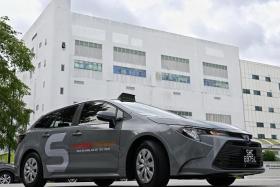Smart transportation is key to S’pore
Building more autonomous and efficient transport systems is one of the crucial elements to achieve its Smart Nation ambitions
A staggering $63.4 billion has been earmarked for investment in smart city technology in the Asia-Pacific region.
In Singapore, the nation strives to rev up its smart city ambitions, and smart transport is one of the crucial elements to achieve that.
There is a need to think "smart" to minimise the impact of the swell in population and car ownership, and the resulting infrastructure bottlenecks.
Recently, the Ministry of Transport announced plans for the deployment of autonomous shuttles in Sentosa. Developed by ST Engineering, these smart shuttles can be hailed via smartphones and kiosks located around the island when trials start next year .
Building transport infrastructure alone is not sufficient; smart transportation is key to addressing ever-growing passenger demand. Simply adding more roads does not help - we need to optimise the capacity of a city - particularly in existing central business districts that cannot easily accommodate expansion.
INTERCONNECTED TRANSPORT
To deliver this optimisation, we need ways to integrate the latest "hardware" developments, that is, roads and rail lines, with connectivity to the latest digital solutions and innovations.
When we say "smart", it is beyond what many cities are doing today.
For example, traffic lights typically are timed and programmed based on historical data with settings that only alter slightly to accommodate traffic in day versus night, rigid to set-points that do not adjust.
With smart transportation using smart flow systems, we can assess traffic flows in real time thanks to sensors and video capture, then adjust intervals based on dynamically calculated data to respond to medians and peaks.
SURGE IN RIDE-HAILING SERVICES
In Singapore, the ride-hailing industry is constantly innovating. Recently, we saw the entry of Mass Vehicle Ledger (MVL), a ride-hailing application that promises to build an incentive-based blockchain mobility ecosystem here.
Leveraging blockchain technology, MVL aims to move away from a centralised system, while linking all car-related services together and compiling all its lifetime data.
SMART TRANSPORTATION IN ASIA-PACIFIC
Locally, the Ministry of Transport and the Land Transport Authority announced that autonomous scheduled buses and autonomous on-demand shuttles will serve commuters in Punggol, Tengah and the Jurong Innovation District from 2022.
The Government is also looking into more efficient transport systems via open data and analytics of commuters' data to improve the commuting experience.
Also, the Centre of Excellence for Testing and Research of Autonomous Vehicles at the Nanyang Technological University continues to work to develop standards for safe integration of self-driving vehicles in our transport system.
We don't know how long it will take for all systems in transportation to be interconnected with each other.
But we want to get to a destination where car drivers, transport passengers and walking or cycling citizens are all communicating with, data-sharing with, and benefiting from, the amalgam of analyses which can be derived from such an interconnected approach.
The writer is director of business development - emerging ecosystems, Asia-Pacific at Equinix.
Get The New Paper on your phone with the free TNP app. Download from the Apple App Store or Google Play Store now


